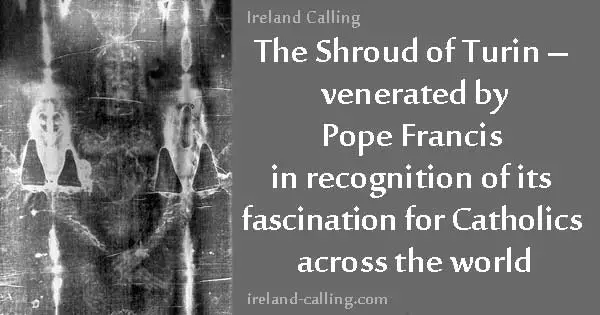The Shroud of Turin – which shows a full length image of a Christlike figure – has fascinated people for centuries. It was given further prominence when it was venerated by Pope Francis in recognition of its great significance to millions of Catholics around the world.
The Shroud is thought by some to be the burial wrapping of Jesus Christ. Others believe it dates back to medieval times. No-one can explain with any certainty how the image of a man came to appear on the historic cloth.

The image of a bearded man is believed to be Jesus by many. Scientists are convinced the cloth can be dated to the 13th or 14th century, after a team of experts studied scraps of the linen in 1989. The scientists used a process called radiocarbon dating, which measures the decay of a natural radioactive form of carbon, in this case when the carbon in the linen was part of a living plant.
However, despite this evidence, there some theories that the pieces of cloth studied were not part of the original Shroud, but later additions. Another possibility put forward is that the carbon dating process was reset by a fire in the 16th century.
How the image of the man got on to the Shroud has baffled scientists and historians for centuries.
There are several theories put forward. One is that the image was painted on to the cloth, but this can be dismissed by the fact that there are no traces of paint pigments. The image is formed by the actual fibres of the Shroud which are different colours.
There is also no solid evidence that the image was burnt on to the fibres of the cloth.
An argument was put forward by French biologist Paul Vignon in the early 20th century that the image could have been formed by a chemical reaction between the fibres of the fabric and a substance exuded by the human body. Vignon suggested that ammonia or urea could have emanated from the body of the man wrapped in the Shroud, and created a chemical reaction to form the picture. Another scientist suggested that lactic acid could also be the substance behind the image.
Another possible explanation is that the image is some form of early photograph. South African historian Nicholas Allen has said that the image could have been formed by shining light on to tiny particles of silver nitrate, causing them to darken in colour. The light must have been shone through quartz instead of glass, as the silver is darkened by ultra-violet light which is absorbed by glass. This knowledge was available as early as the 8th century, as it appears in the writings of Arabic scientist Jabir ibn Hayyan. The image could have been formed by a primitive photograph experiment. However, this theory doesn’t explain why the cloth itself had changed colour, once the silver particles were removed.
A further theory from the Yahoo Shroud Science Group is that the image was formed by some sort of energy release, possibly beyond scientific explanation. They claim that “an energy source coming from the enveloped man correlated to surface electrostatic discharges caused by an electric field”. Simply put, the theory is that the image was formed by an incredible blast of light emanating from the body of the man, as he returned from the dead.
What is so fascinating about the Shroud of Turin is that no-one knows how the image came to appear on it. All theories have their merits, but also their shortfalls in terms of evidence.
What is certain is that it is a significant item in the eyes of many Catholics around the world. Pope Francis recognised that by venerating it shortly after taking office, thus adding to its fascination and mystique.